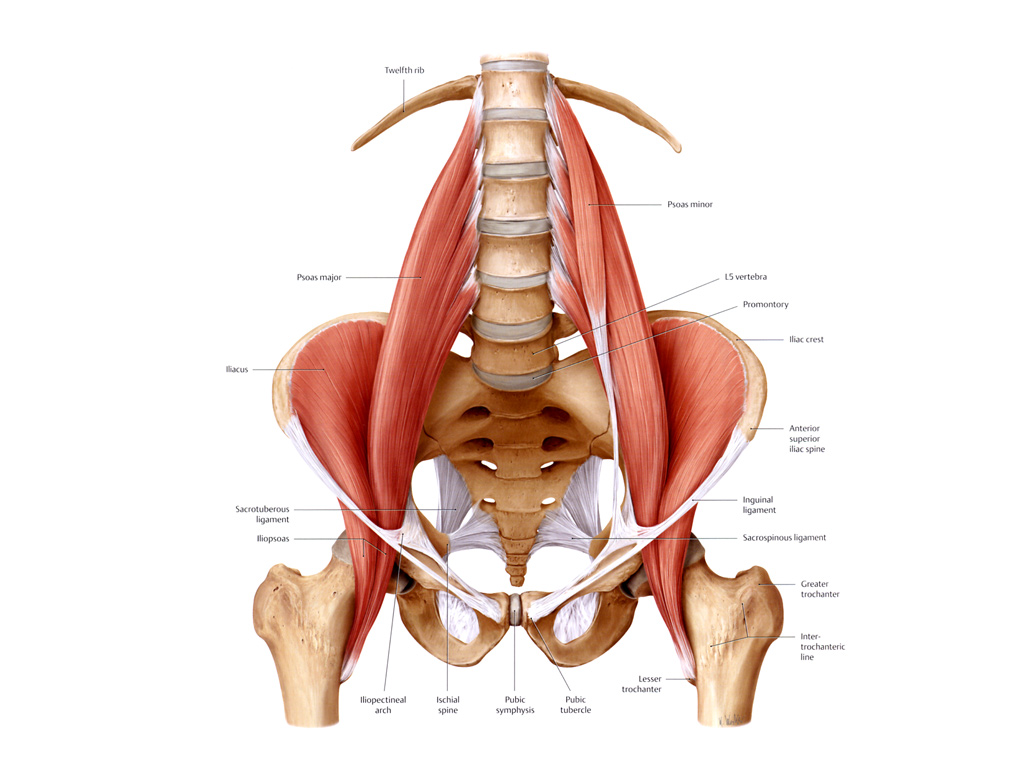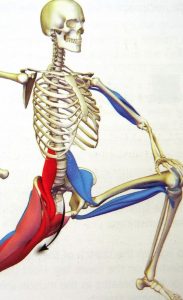
Ah the old Psoas muscle. Pronounced ‘So-as’, it is such an important muscle, though often overlooked as the cause of lower back pain, most likely due to it’s hidden nature. I tell you what though, just because you can’t see it bulging out of the leg does not mean it is not a fancy muscle, oh yes it is fancy. It does so many things and where it starts and ends shows why. It is often called the muscle that links the upper and lower halves of the body.
The psoas’ origin is along the transverse processes of T12-L5 vertebrae, so literally the entire lumbar spine. It then passes through some internal organs, through the front of pelvis and attaches the lesser trochanter (small knuckle) of the giant Femur bone.

So just knowing that you can tell why it would be so problematic. If the muscle becomes really tight and short due to excess hip flexion over time, it can pull like claws on the lumbar spine, effectively clamping the spine together and causing an anterior (forward) tilt of the pelvis.
While the psoas’ main role is as a hip flexor, it also assists in flexing the leg, and flexing the torso with the leg stabilized, bringing the body up from a lying down position. It also does a lot more though and it interacts with another muscle called the Illiacus. Together they form the Illio-psoas, but we will cover that more when we go through the release.
Self Myofascial Release is a term used for any self-administered soft tissue release, usually with the use of tools such as a Foam Roller or ball. Well today, due to the nature of the psoas muscle and the chronicity of it’s tightness, we are going to use either a rubber coated weight plate or even a kettlebell. Whatever allows for easy access to the muscle itself. Watch the video below to see a demonstration.
As you can see from the video, the pressure is applied on the edge of the muscle, closer to the Illiopsoas portion, but effectively it is the same structure, and will resolve just as easily.
Because of the nature of the muscle a release or active release via SMR is important to do before stretching so the neuromuscular components of the muscle, being the spindle cells and Golgi tendons can get different feedback, which then allows them to start re-setting the muscle length.
 So now we have done the release we can move onto the stretch. The positioning is important here. We need to create length through the muscle, first by pushing the pelvis forward. In that position, you want to have a neutral spine, so you may have to tuck the pelvis under.
So now we have done the release we can move onto the stretch. The positioning is important here. We need to create length through the muscle, first by pushing the pelvis forward. In that position, you want to have a neutral spine, so you may have to tuck the pelvis under.
This should create more stretch. Then push forward again until you feel it, and you can lean over to the  opposite side, creating even more stretch. You want to hold the stretch for a minimum of 45 seconds. After then the spindles will start to let go and you can start creating length. Remember with any stretch, the exhalation is where the stretch happens, the muscles will want to let go on the exhale, and tighten on the inhale, so always do stretching with a bit of mindful focus.
opposite side, creating even more stretch. You want to hold the stretch for a minimum of 45 seconds. After then the spindles will start to let go and you can start creating length. Remember with any stretch, the exhalation is where the stretch happens, the muscles will want to let go on the exhale, and tighten on the inhale, so always do stretching with a bit of mindful focus.
The application…
As with any training, as a general rule, stretching and SMR should be done either at the end of training or as a stand-alone session. Mobilizations and active stretches can be done before training to warm up the muscle and joints but leave the lengthening for last in the session when the muscles are warm.
If you are experiencing any mild lower back pain, this exercise can be useful to do a few times per week, but if you have any questions on the application, please ask Ambrose or Nick and they will endeavor to guide you through process.
If however you are experiencing severe and/or chronic back pain, please either consult your regular musculoskeletal practitioner, or come and see the Myotherapy/Rehabilitation department where we can assess you further and guide you from there.
Good luck!
No Comments to "Self Myofascial Release for Back Pain: Psoas muscle"